The Lazard Global Total Return and Income Fund Inc (NYSE:LGI) is a closed-end fund, or CEF, that investors can use to earn a high level of current income from the assets in their portfolios. One of the nicest things about this fund is that it invests in equity securities from all around the world. This is an advantage over most high-yielding closed-end funds that invest in fixed-income securities because equities are somewhat better at protecting the purchasing power of a person’s wealth than fixed-income securities.
In a previous article, I showed that the inflation problem is not nearly as solved as some market participants and policymakers may want to believe. In particular, core inflation has actually increased on a month-over-month basis. This suggests that an interest rate cut, presumably in response to a weakening economy, could reignite inflation and lead to 1970s-style stagflation. In the 1970s, domestic common equities did not do particularly well, as the Dow Jones Industrial Average (DJI) only went from approximately $800 to $839 over the ten-year period. If that same performance were to occur in another period of stagflation, investors in domestic common equities could be disappointed.
In my previous article on this fund, I pointed out a potential advantage that the Lazard Global Total Return and Income Fund could have over most domestic equity funds:
Recent projections from the Congressional Budget Office reveal how important it is to diversify your portfolio across nations and currencies, as these projections point to considerable fiscal deficits going forward that seem almost certain to reduce the strength of the U.S. dollar compared to other currencies. Central banks all over the world have started to realize this, with central bank gold purchases setting a record in 2022 and almost matching that level in 2023.
The fact that this fund can invest in foreign securities allows it to profit just from one currency appreciating against the U.S. dollar, which could allow for capital gains even if equity markets go nowhere. Of course, even if the U.S. stock market does not deliver acceptable gains due to weak economic conditions, the markets located in certain foreign countries might still perform reasonably well. This fund can take advantage of this situation.
It is also worth noting that on Friday, Goldman Sachs released a report to its clients regarding the potential results of the upcoming elections on the market. For this report, Goldman Sachs simply looked at the victory odds for each of the two presidential candidates and party Congressional elections and correlated them with what the equity, currency, and bond markets did at times in which one outcome was projected by the odds market. This report does not appear to be available for free anywhere on the Internet, which is unfortunate. The important point for our purposes today is that only one of the four possible Federal election outcomes analyzed by Goldman Sachs had U.S. stocks outperforming foreign assets. Thus, this could serve as another argument to include a fund such as the Lazard Global Total Return and Income Fund in a portfolio, as it will provide exposure to outperforming foreign markets in three of the four scenarios.
As just mentioned, we last discussed the Lazard Global Total Return and Income Fund at the start of July 2024. The global equity markets have been remarkably strong since that time, which is at least partially due to the central banks of a few developed countries adopting a more dovish stance. The European Central Bank, Bank of Canada, and the Bank of England have all reduced their policy rates in the past six months, and the Federal Reserve in the United States is expected to do so over the coming days. This sparked a rally in both domestic and foreign markets as market participants began to party as though the 2010s were back. We might expect that the Lazard Global Total Return and Income Fund has also delivered a strong performance over the period.
Unfortunately, this fund has not done as well as we might have hoped. As we can see here, the Lazard Global Total Return and Income Fund has only appreciated by 1.61% since the date of our previous discussion:
Seeking Alpha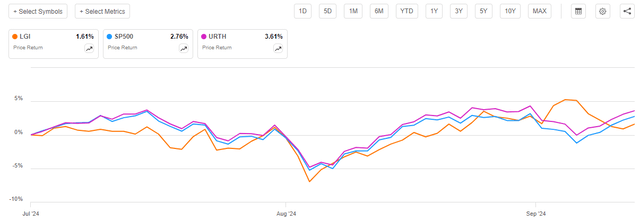
Perhaps the most disappointing thing here is that the fund underperformed both the S&P 500 Index (SP500) and the MSCI World ETF (URTH). This might reduce the opinion that some investors have of this fund, since nobody likes to underperform the market. However, we do see that the fund was outperforming the two indices during the first week of September, but it has since fallen back to Earth. Despite the underperformance, we do see that the fund’s share price largely followed the general direction of the indices, which we would expect based on the securities that it holds.
It is important to note that investors actually did better over the period than the above chart suggests. As I stated in my previous article on this fund:
Closed-end funds typically pay out most or all of their investment profits to their investors in the form of distributions. The basic objective is to keep the portfolio relatively stable in size while giving the investors all of the profits. This differs somewhat from an exchange-traded fund that rarely has any realized capital gains and depends primarily on share price appreciation to reward its investors. The fact that these funds pay out all of their investment profits is the reason why they tend to have higher yields than just about anything else in the market. It also results in shareholders doing much better than the price performance alone would suggest. Therefore, we need to include the distributions that the fund pays out in any discussion of its performance.
When we include the distributions that the Lazard Global Total Return and Income Fund paid out over the past few months, we get this alternative chart to the one shown previously:
Seeking Alpha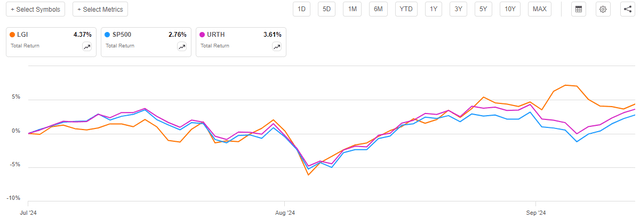
This certainly makes the performance of the Lazard Global Total Return and Income Fund look better, as the fund actually managed to beat both the S&P 500 Index and the MSCI World Index on a total return basis. It is also worth noting that the MSCI World Index beat the S&P 500 Index over the period, which provides a bit of support for my previous statements that global stocks could be looking more attractive than domestic ones. This chart suggests that the Lazard Global Total Return and Income Fund could be an attractive way to play this thesis.
As two-and-and-a-half months have passed since our previous discussion, it is logical to assume that some things have changed with both this fund and in the macroeconomic environment. In particular, the fund recently released its semi-annual report, so we will want to pay close attention to that as it will give us a lot of insight into how well this fund is covering its distribution. The remainder of this article will focus on discussing these changes and updating our thesis as necessary.
About The Fund
According to the fund’s website, the Lazard Global Total Return and Income Fund has the primary objective of providing its investors with a high level of total return. This objective makes a great deal of sense given the fund’s strategy, which is described on the website:
Lazard Global Total Return & Income Fund is a closed-end investment company that seeks a total return consisting of capital appreciation and current income. The Fund seeks to achieve its objective by investing in a portfolio of approximately 60-80 US and non-US equity securities, generally with a market cap of $2 billion or greater, at the time of purchase and may invest in emerging markets. It seeks enhanced income by investing in short duration (typically below one year) emerging market forward currency contracts and other emerging markets debt instruments.
This description strongly suggests that the bulk of this fund’s assets will be invested in equity securities, which is confirmed by the semi-annual report. The schedule of investments in that document provides the following asset allocation as of June 30, 2024:
|
Asset Type |
% of Net Assets |
|
Common Stocks |
101.0% |
|
Foreign Government Bonds |
6.5% |
|
Short-Term Investments |
2.3% |
Clearly, the overwhelming majority of the fund’s assets are invested in equity securities. As I stated in my previous article on this fund:
Common equities are by their nature total return vehicles. After all, investors typically purchase common equities both to receive an income via the dividends that these securities pay out as well as benefit from the capital gains that should accompany the growth and prosperity of the issuing company.
Total return is generally considered to be a combination of capital appreciation and current income. As common equities deliver their returns via both of these methods, any fund that invests primarily in common equities should have a total return objective. The Lazard Global Total Return and Income Fund clearly satisfies this requirement.
In the previous article on this fund, we saw that it was fairly heavily exposed to the United States. This appears to still be the case today, as the fact sheet provides the following asset allocation as of July 31, 2024:
LGI Fact Sheet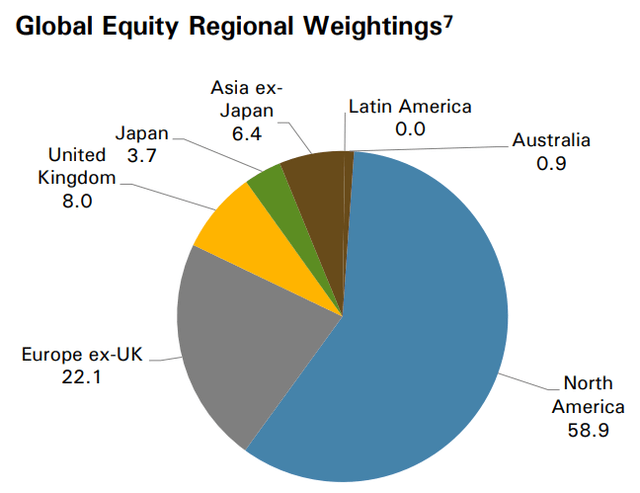
The fact sheet does not explicitly break down the fund’s assets by country, which is unfortunate. There are quite a few investible countries in these different regions that have very different fundamentals. For example, North America includes both the USA and Canada. The market performance of these two countries has been very different over time, with the United States dramatically outperforming Canada over the past decade. This chart shows the S&P 500 Index against the iShares MSCI Canada ETF (EWC):
Seeking Alpha
Obviously, we would have much rather the fund had a larger weighting to the United States than to Canada over most of that period.
The same is true of Europe, with Germany (EWG) substantially outperforming Spain (EWP):
Seeking Alpha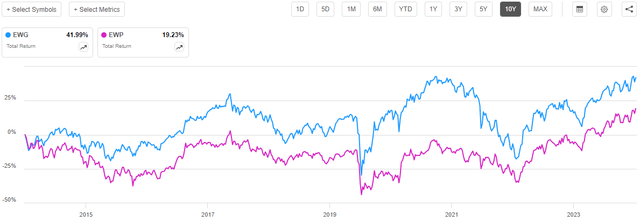
I only chose these particular countries as an example, but it makes the point that some countries are better to invest in than others. In addition, some investors might have significant exposure to one particular country already in their portfolio, and so they want to avoid investing more money into it for diversification purposes. The information that this fund provides in its fact sheet does not help us to the extent that we might want.
With that said, we do notice that the fund has slightly altered its exposure to a few regions since our last discussion:
|
Region |
% Allocation Today |
% Allocation Previous |
% Change |
|
North America |
58.9% |
58.8% |
+0.1% |
|
Europe ex-UK |
22.1% |
22.5% |
-0.4% |
|
United Kingdom |
8.0% |
8.0% |
No Change |
|
Japan |
3.7% |
3.4% |
+0.3% |
|
Asia ex-Japan |
6.4% |
6.4% |
No Change |
|
Latin America |
0.0% |
0.0% |
No Change |
|
Australia |
0.9% |
0.9% |
No Change |
We see slight increases in the fund’s exposure to North America and Japan, along with a slight decrease in its European Union and Switzerland exposure. To a certain point, this makes sense as the United States has outperformed the Eurozone (EZU) since June 1, 2024:
Seeking Alpha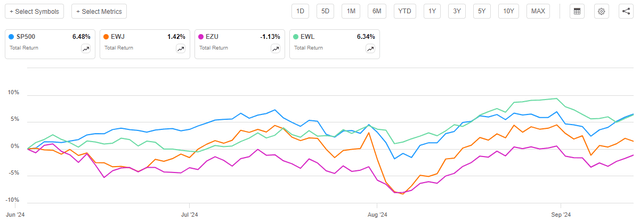
However, we can see that Japan (EWJ) underperformed both the United States (represented by the S&P 500) and Switzerland (EWL). The fund does not state whether its allocation to Switzerland relative to the rest of Europe increased over the past few months, though, so we do not know the extent to which the fund actually benefited from the relative performances of these countries. Hopefully, its allocation to the Eurozone decreased by more than 0.4% while its allocation to Switzerland increased to make the overall decrease to Europe excluding the United Kingdom 0.4% of net assets. We cannot know this for certain, however.
The fund’s semi-annual report provides the following country allocation as of June 30, 2024:
|
Country |
% of Net Assets |
|
Australia |
0.9% |
|
Canada |
2.9% |
|
China |
2.7% |
|
Denmark |
1.6% |
|
Finland |
0.8% |
|
France |
2.7% |
|
Germany |
0.8% |
|
Hong Kong |
1.6% |
|
India |
1.2% |
|
Japan |
3.2% |
|
Netherlands |
3.7% |
|
Spain |
1.2% |
|
Sweden |
2.8% |
|
Switzerland |
3.4% |
|
Taiwan |
2.9% |
|
United Kingdom |
7.9% |
|
United States |
60.7% |
There could be some differences between these figures and the regional chart provided in the fund’s fact sheet for two reasons:
- The fact sheet is dated July 31, 2024, but the schedule of investments provided in the semi-annual report is dated June 30, 2024. Thus, the fund could have introduced some changes to its holdings over the one-month period.
- The figures provided in the fact sheet are a percentage of total assets, whereas the figures provided in the semi-annual report are a percentage of net assets. Due to the fund’s leverage, the figures provided in the semi-annual report will total more than 100%.
Regardless of the differences that are caused by the differing dates and calculation methods provided by the two sources of information from the fund’s sponsor, we can still see that the Lazard Global Total Return and Income Fund remains heavily exposed to the United States. This, unfortunately, weakens the thesis that was presented in the introduction. That thesis being the use of the fund as a way to invest in foreign markets due to possibly better returns elsewhere. If the fund is majority weighted to the United States, then it is not fully taking advantage of that opportunity. As we saw in the introduction, the MSCI World Index has actually outperformed the S&P 500 Index since July, which tells us that foreign stocks have been outperforming domestic ones over the past two months. This fund thus would have done better had its exposure to the United States been lower than it is.
With that said, the Lazard Global Total Return and Income Fund does have a lower domestic stock exposure than the MSCI World Index itself. This chart shows the geographic weightings of the MSCI World Index as of September 12, 2024:
BlackRock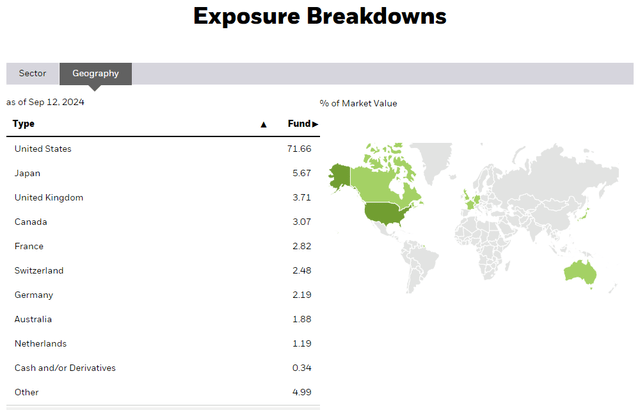
As clearly shown, the United States currently accounts for 71.66% of the MSCI World Index. The Lazard Global Total Return and Income Fund thus provides more exposure to international markets than the index. We specifically note that the fund’s weightings to the United Kingdom and Switzerland appear to be significantly higher than that of the index, which is probably a good thing given the strong performance of Swiss equities compared to a few others over the past few months.
Thus, the Lazard Global Total Return and Income Fund does not appear to be a perfect way to gain exposure to international markets, as it does still have significant domestic stock exposure. However, it does do a better job at providing foreign stock exposure than many other options that investors may choose to use. Presumably, too, its active nature could result in the fund’s management increasing the fund’s weightings to other countries should they start outperforming the United States, as is always a possibility.
Leverage
As is the case with most closed-end funds, the Lazard Global Total Return and Income Fund employs leverage as a method of increasing the yield and overall total return that it earns from the assets in its portfolio. I explained how this works in my previous article on the fund:
In short, the fund borrows money and then uses those borrowed monies to purchase stocks and other assets. As long as the total return of the purchased securities is greater than the interest rate that the fund has to pay on the borrowed money, the strategy works pretty well to boost the overall yield of the portfolio. This fund is capable of borrowing money at institutional rates, which are considerably lower than retail rates. As such, this will usually be the case.
However, the use of debt in this fashion is a double-edged sword. This is because leverage boosts both gains and losses. As such, we want to ensure that the fund is not employing too much leverage because that would expose us to too much risk. I generally do not like to see a fund’s leverage exceed a third as a percentage of its assets for this reason.
As of the time of writing, the Lazard Global Total Return and Income Fund has leveraged assets comprising 30.26% of its overall portfolio. This represents a decrease from the 31.40% leverage that the fund had the last time that we discussed it. As we saw in the introduction, the fund’s share price increased over the period, so we expected the leverage to decrease. After all, a rising share price typically correlates with a growing portfolio.
However, one thing that we have seen over the past few weeks is that several closed-end funds have seen their share prices rise more rapidly than is justified by the performance of the underlying portfolio. That was the case with this fund over the past two-and-a-half months, as its net asset value has only increased by 1.86% since our previous discussion:
Barchart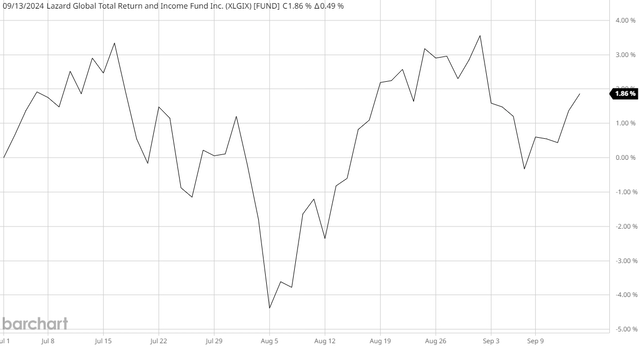
As the fund’s net asset value has increased, we can expect its leverage to have decreased. After all, the fund’s outstanding borrowings would represent a smaller proportion of the overall portfolio following such growth, assuming that the fund does not borrow any more money. This appears to have been the case here.
The Lazard Global Total Return and Income Fund currently has a level of leverage that is lower than the one-third maximum level that I typically prefer to see. However, it is not below that level by very much, and some strategies are riskier than others. We should therefore compare this fund with its peers to ensure that it does not have too much leverage for its particular strategy. Here is a table summarizing the peer comparison:
|
Fund Name |
Morningstar Classification |
Leverage Ratio |
|
Lazard Global Total Return and Income Fund |
Equity-Global Equity |
30.26% |
|
Allspring Global Dividend Opportunity Fund (EOD) |
Equity-Global Equity |
17.10% |
|
Clough Global Equity Fund (GLQ) |
Equity-Global Equity |
30.46% |
|
Eaton Vance Tax-Advantaged Global Dividend Income Fund (ETG) |
Equity-Global Equity |
18.90% |
|
Royce Global Trust (RGT) |
Equity-Global Equity |
4.77% |
|
abrdn Total Dynamic Dividend Fund (AOD) |
Equity-Global Equity |
2.64% |
(All figures from CEF Data.)
As we can immediately see, the Lazard Global Total Return and Income Fund employs more leverage than most of its peers. While it is not the most leveraged fund in the sector, it is pretty close, and that suggests that the fund may be using more leverage than some investors would be comfortable with. At any rate, this leverage does mean that the fund might be more volatile than some of its peers, so risk-averse investors might want to consider that before purchasing shares.
Distribution Analysis
The primary objective of the Lazard Global Total Return and Income Fund is to provide its investors with a high level of total return. As is the case with most closed-end funds, though, it primarily delivers its total return by making regular distributions to its investors. The fund currently pays a monthly distribution of $0.1494 per share ($1.7928 per share annually). This gives the fund a very attractive 10.52% yield at the current share price. As we can see here, this is quite a bit higher than many of its peers:
|
Fund Name |
Current Yield |
|
Lazard Global Total Return and Income Fund |
10.52% |
|
Allspring Global Dividend Opportunity Fund |
9.60% |
|
Clough Global Equity Fund |
10.69% |
|
Eaton Vance Tax-Advantaged Global Dividend Income Fund |
8.17% |
|
Royce Global Trust |
1.32% |
|
abrdn Total Dynamic Dividend Fund |
13.50% |
Thus, this fund could be somewhat more attractive to income-hungry investors than its lower-yielding peers.
Unfortunately, the fund has not been especially consistent regarding its distribution over the years. We can see this here:
CEF Connect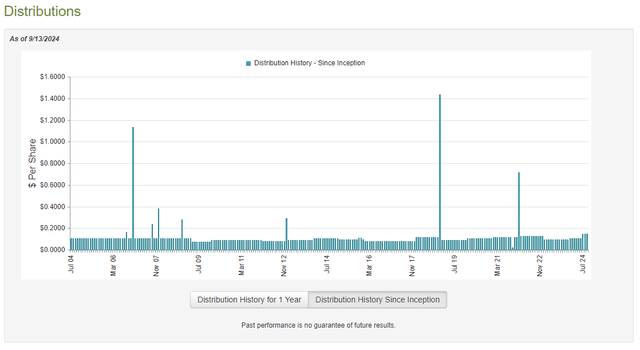
As I stated in the previous article on this fund:
The distribution history might prove to be something of a turn-off for those investors who are seeking a safe and secure income to use to cover their bills or finance their lifestyles. After all, it is much more difficult to budget your spending activities when your income can change significantly from period to period, as investors in this fund tend to experience. However, at the same time, it is natural for many closed-end funds to change their distributions on a regular basis to correspond to the actual performance of their portfolios. This generally ensures that the fund is not paying out more money than it can actually afford and destroys its net asset value in the process. The more a fund’s net asset value is depleted, the worse its sustainability going forward and the harder it is for the fund to meet a specified level of distribution.
As we saw in the previous article, the Lazard Global Total Return and Income Fund increased its distribution back in January. It increased it again in July:
CEF Connect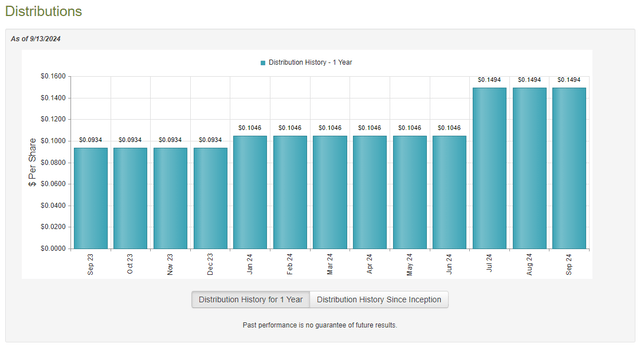
This is almost certainly a response to the strong equity market conditions that existed during the first half of this year. As stated in the quote, the fund regularly changes its distribution based on the performance of its assets. This distribution was a fairly large 42.83% from the previous level, and it certainly pleased anyone who bought it at the time my last article was published. After all, this fund is now paying a higher distribution than it was previously.
Naturally, though, we should take a look at the fund’s performance to ensure that it is properly covering the distribution, since we do not want this increase to be destructive to its net asset value. The most recent financial report for this fund is the semi-annual report for the six-month period that ended on June 30, 2024. A link to this report was provided earlier in this article, and as this is a newer report than the one that was available the last time that we discussed the fund, it should work pretty well as an update.
For the six-month period that ended on June 30, 2024, the Lazard Global Total Return and Income Fund received $1,870,766 in net dividends and $842,991 in net interest (both figures are after deducting foreign withholding taxes). This gave the fund a total investment income of $2,713,757 for the six-month period. The fund paid its expenses out of this amount, which left it with $110,688 available for shareholders. This was not sufficient to cover the $8,166,142 that the fund paid out in distributions during the six-month period.
Fortunately, the fund was able to make up the difference via capital gains. For the six-month period that ended on June 30, 2024, the Lazard Global Total Return and Income Fund reported net realized gains of $7,685,004 along with $5,358,025 of net unrealized gains. Overall, the fund’s net assets increased by $4,987,575 after accounting for all inflows and outflows during the period.
The fund therefore was able to nearly entirely cover its distribution out of net investment income and net realized gains. This is a pretty good sign, and it should indicate that the fund is okay financially. We should not have to worry too much about a near-term distribution cut unless the market declines significantly in the near future.
Valuation
Shares of the Lazard Global Total Return and Income Fund are currently trading at a 7.99% discount to net asset value. This is slightly worse than the 8.88% discount that the shares have had on average over the past month. As such, it might be possible to get a slightly better price by waiting a few days before buying. The current price is not at all bad, though.
Conclusion
In conclusion, foreign stocks have outperformed American ones over the past two or three months. This might be due to uncertainty about the economic and political direction of the United States, or it could simply be due to the market realizing that American assets are quite richly valued relative to the equities found in various foreign markets. The Lazard Global Total Return and Income Fund provides exposure to these foreign markets, and it does a bit better at it than most of the global indices. The fund has delivered a higher total return than either domestic or foreign stocks recently, which is another thing that it has in its favor. The fund’s yield is quite attractive, and it trades discounted to net asset value, so it might be worth considering as a way to get exposure to foreign assets.
Editor’s Note: This article covers one or more microcap stocks. Please be aware of the risks associated with these stocks.
Read the full article here



